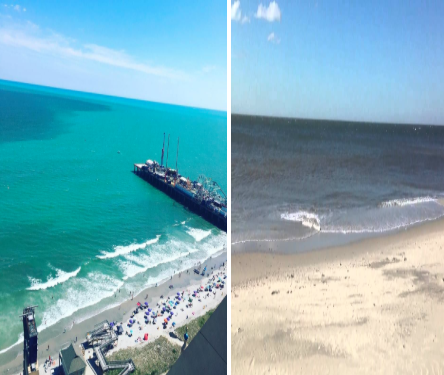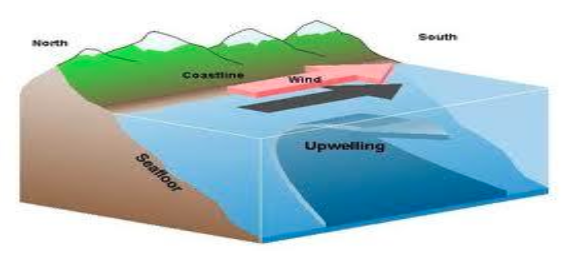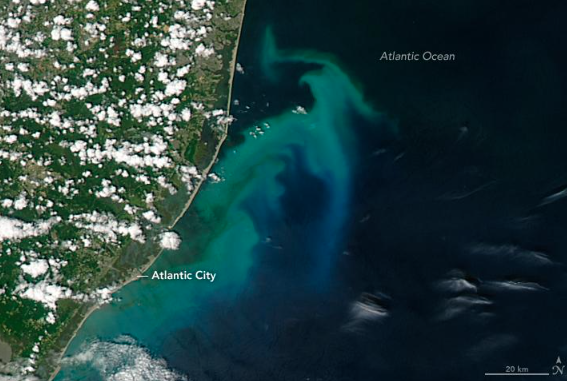Phytoplankton Bloom of Cape May, New Jersey; July 2016
As the Atlantic Star rocked back and forth the blue-green tinted water glared back up at me. I could see hundreds of Atlantic Menhaden and countless Cownose Rays swimming several feet beneath the surface. No, I was not in the Bahamas or the Caribbean or even remotely close for that matter. This was the coast of Cape May, New Jersey. For those of you familiar with the coastal waters of New Jersey, they are often far from the tropical green that it was in early July. New Jersey beachgoers are all too familiar with murky grey waters of the North Atlantic Ocean, which sharply contrasted the tropical colors I was seeing. The normal murky water of the North Atlantic is not because it is “dirty,” but actually because it is teaming with life. Our turbid water is so rich with nutrients and plankton that you do not get the same visibility as you would in the crystal clear waters of the Caribbean. These clear tropical waters are in fact barren of the nutrients that are found in the turbid waters of our coast. This leads to the question; why were the turbid waters of New Jersey suddenly looking like they were from the tropics? There were many factors involved, but primarily two culprits: a phytoplankton bloom and a drought.

Images comparing the beaches of Atlantic City during the bloom and Cape May before the bloom
Phytoplankton, microscopic plant life found throughout the ocean, are at the bottom of the oceanic food web. Unable to swim against the current, their movements are primarily based upon the ocean currents and wind. So how did these little critters contribute to the coloring of the water? Phytoplankton, like all plants, have chlorophyll. Chlorophyll is a green pigment that plants have to absorb sunlight in order to convert it to energy. Chlorophyll appears green because it reflects back blue to green wavelengths of light. When a phytoplankton bloom, or an abundance of phytoplankton caused by weather conditions occurs, the concentration of chlorophyll in the water causes a blue-green tint.

Phytoplankton
How does the phytoplankton bloom occur in the first place? This is caused by an event called upwelling. Upwelling occurs from a complex movement of winds and water off the coastline. As winds blow parallel to the coast, the rotation of the Earth can cause water to move perpendicularly to the wind and away from the shore. As the surface waters are pushed further offshore, water is drawn from below to replace it. This colder, more nutritious water brought to the surface is a critical factor for what causes the phytoplankton blooms to transpire. During the upwelling that caused the phytoplankton bloom in July, scientists noticed shore temperatures dropping down to as low as 60 degrees Fahrenheit while offshore temperatures increased upwards to as high as 75 degrees Fahrenheit.

Graphic representation of upwelling from NOAA
I have talked about why the water was blue. But some of you might be wondering how more things floating in the water somehow made it clearer. This answer to this is a drought. Inland New Jersey had been suffering abnormally dry weather patterns for a few months prior to the bloom. Scientists hypothesize that this significantly reduced freshwater runoff into the ocean largely contributed to the newfound clarity of the Atlantic Ocean.
Are these phytoplankton blooms dangerous? The dangers of phytoplankton blooms vary from species to species. Some are known to produce very harmful toxins. Other blooms on the other hand are non-toxic. The phytoplankton bloom off the coast of New Jersey belonged in the latter group, with no observable ill side effects. Phytoplankton actually helps the whole world as it produces between 70-80% of the oxygen we breath! These blooms also help support the local marine life by attracting many types of small animals, including zooplankton, krill, and small fish. These small animals in turn attract larger fish, dolphins, and even whales that will feed on them.

Image of Phytoplankton bloom from space, July 2016, taken by NASA
Unfortunately this phenomenon only lasted little over a week before weather conditions changed and the clarity and tropic colors were lost. While uncommon for phytoplankton blooms off the coast of New Jersey to last this long, they do occur every now and again for a few days. So if you find yourself in the area, swing by our lovely shores for the chance to see this nonpareil event.
-Jeremiah Buttram, Franciscan University of Steubenville;
Intern at Cape May Whale Watch and Research Center
Sources
Gaines, Dr. Steve. “Upwelling” NOAA Ocean Explorer. Web. 3 August, 2016.
Ranosa, Ted. “Phytoplankton Bloom Causing New Jersey Waters To Turn Aquamarine”14 July 2016,Tech Times. Web. 3 August, 2016.
Skeldon, Dan. “Tropically Colored Waters Making A Green Splash in South Jersey”. Press of Atlantic City. Web. 3 August 2016.
